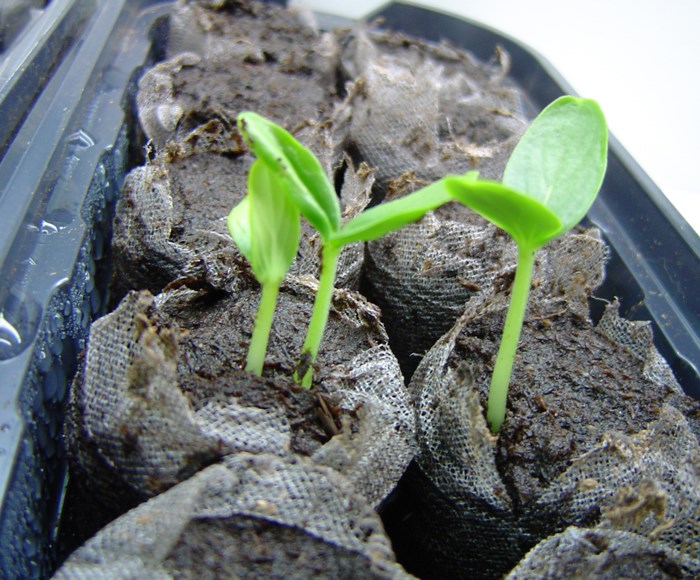Many vine crops such as muskmelon, cucumber, winter squash, pumpkins and watermelon need a “head start” in Saskatchewan. The length of our growing season is just not long enough for them to go from seed to harvest outdoors. They require warm soil and air for seed germination, optimum plant growth and fruit maturation. Furthermore, the old maxim that the larger the transplant, the earlier the crop, does not hold true for vine seedlings: larger vine seedlings usually experience severe transplant shock and delayed growth.
It’s best to transplant vine seedlings after only one true leaf has emerged. In the case of these vines, the first two ‘leaves’ to emerge are the cotyledons (seed storage organs and first photosynthetic tissues). They usually look much different than the plant’s real or true leaves. The third ‘leaf’ that emerges in a vine transplant is called the first ‘true leaf’. If more than one true leaf has emerged before transplanting, the seedling is more likely to undergo transplant shock, resulting in stunted growth or even death. Seedlings that look chlorotic (yellow), appear stunted, and resist growth immediately after transplanting are probably suffering from transplant shock.
Reduce transplant shock in vine vegetable seedlings by minimizing root disturbance. Transplant them when their root systems are still small or grow them in a medium that resists root disturbance during transplanting. This is easily done by using Jiffy #7 peat pots. Soak the compressed peat pellets/discs in warm water for 5 to 10 minutes to saturate them and cause them to expand from 0.5 to 5cm in height. The expanded peat pot is surrounded by a biodegradable netting with a hole on the top end of the peat pot. Insert the seed in the hole of the wet Jiffy #7. Do not remove the netting.
Once the seeds are sown, place the Jiffy #7s ‘hole side up’ in a plastic tray with drainage holes in the bottom. Cover the tray with a clear plastic dome or clear plastic household wrap and place it in a warm location (at least 24˚C). Do not water soaked and seeded Jiffy #7s as excess moisture will cause the seeds to rot.
Depending on the vegetable, seedlings should emerge within 7 to 10 days and will be ready for transplanting outdoors within 14 days. Hardening off the vegetable vine seedlings prior to planting outdoors is extremely important. Place them outdoors in a sheltered sunny location for 3 to 5 days prior to transplanting. Avoid chilling injury by bringing them in at night for the first few days. Do not leave them outdoors until night-time temperatures are above 8-10˚C. If outdoor daytime/night-time air temperatures are below 20˚C/8-10˚C respectively, and the soil temperature is below 15˚C, delay transplanting until average temperatures improve.
When transplanting Jiffy #7 peat pots to their permanent outdoor location, ensure that the roots are not disturbed and completely submerge the peat pots in the soil. Any portion of the peat pot that is exposed above the soil surface will act as a wick, drawing water away from the tender transplant.
Not all vegetable vines need to be transplanted. I always seed cucumbers and pumpkins directly into the garden soil as I have a sheltered garden that warms up early in the spring. The key to direct seeding into garden soil is to provide warm soil for fast and efficient seed germination. Cool soil encourages seed rot before germination can take place. Watermelon, cantaloupe and longer season winter squash all require warmer soil temperatures for seed germination than can typically be found in a Saskatchewan garden in May. These should always be started indoors and then transplanted to the garden.
Jackie Bantle is a horticulturalist living in Saskatoon.
This column is provided courtesy of the Saskatchewan Perennial Society (www.saskperennial.ca; [email protected]; NEW www.facebook.com/saskperennial). Check out our Bulletin Board or Calendar for upcoming garden information sessions, workshops and tours.




